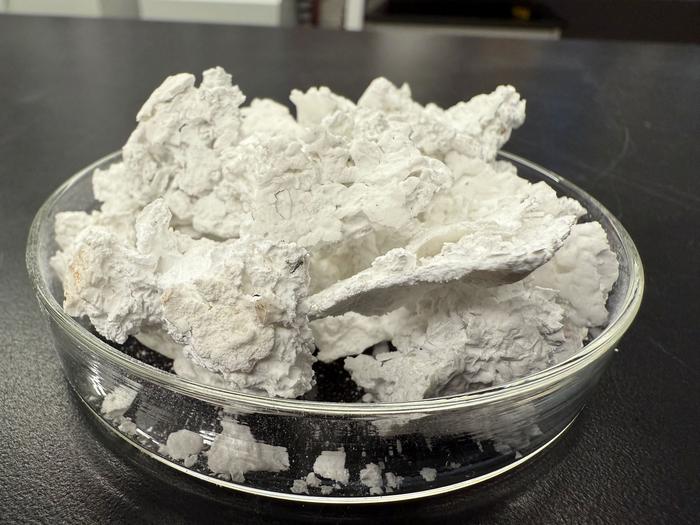In a groundbreaking development within the realm of sustainable construction materials, scientists at Northwestern University have unveiled a novel carbon-negative building substance that has the potential to revolutionize the construction industry and significantly mitigate greenhouse gas emissions. This innovative material is produced by utilizing seawater, electricity, and carbon dioxide (CO₂), effectively transforming a waste product into a valuable resource, thus addressing dual challenges in the fight against climate change.
In light of the escalating climate crisis, the extraction of CO₂ from the atmosphere and its secure storage has garnered increasing attention from researchers across the globe. In many existing carbon capture methods, while atmospheric CO₂ can be effectively sequestered, the inherent value of this greenhouse gas is often overlooked. The pioneering research led by a team from Northwestern takes a transformative approach by both capturing CO₂ and converting it into useful building materials like concrete, cement, plaster, and paint. This dual-purpose method not only reduces the atmospheric carbon burden but also contributes to the sustainable production of ubiquitous construction materials.
Led by Alessandro Rotta Loria, an assistant professor at Northwestern’s McCormick School of Engineering, the research team has successfully developed a method that leverages seawater and electrical energy to create sand-like materials. Cement and concrete are traditionally reliant on sand derived from the earth’s aggregates. The sustainable technique developed by Rotta Loria and his colleagues bypasses the need for mining these essential minerals. Instead, they utilize a combination of CO₂ injection and electrochemical processes to cultivate sand constituents directly in seawater.
The implications of this technology are profound. The captured CO₂, injected into seawater, engages in a chemical reaction whereby it alters the water’s composition, enhancing the concentration of bicarbonate ions. These ions then react with naturally occurring minerals in seawater such as calcium and magnesium to generate solidified materials like calcium carbonate and magnesium hydroxide. Not only do these substances serve as supplements in concrete and other construction products, but they also function as effective carbon sinks, substantially holding over half their weight in CO₂ emissions.
This carbon-negative material exemplifies nature’s ingenuity, echoing the processes seen in marine organisms like corals and mollusks, which utilize metabolic energy to create calcium carbonate for their shells. The Northwestern team, however, introduces a synergy of electrical energy and chemical manipulation, allowing for greater control over the materials generated. This control enables the examination of multiple factors, including electricity voltage, CO₂ flow rates, and timing, to meticulously tailor the resultant material’s properties. Consequently, a spectrum of textures ranging from porous to more compact forms can be consistently produced, paving the way for various applications in the construction sphere.
The significant milestone in this research includes not just the ability to supercharge the mineralization process with electricity but also its adaptability based on experimental conditions. This flexibility is a game-changer in material science, where the specific requirements for diverse applications can be met without compromising structural integrity. In a construction industry that heavily depends on aggregates for concrete, the promise of a sustainable substitute is both timely and critical amid global efforts to combat climate change.
Additionally, Rotta Loria’s vision extends beyond raw material production. The process can be integrated into modular systems, potentially positioned at shoreline cement plants where oceanic resources are readily available. This promises to streamline the supply chain while minimizing ecological disturbances, ensuring that marine ecosystems remain unaffected. By orchestrating these chemical processes in a controlled setting, the researchers can maintain optimal water quality and minimize detrimental environmental impacts.
In the broader context, the cement and concrete industries are significant contributors to global CO₂ emissions, accounting for around 8% of the total emissions frequently mentioned in climate discussions. By embedding carbon into the very materials that drive construction, Rotta Loria posits the feasibility of creating a circular economy embracing sustainability. A system where construction methods not only reduce the industry’s carbon footprint but also actively contribute to carbon sequestration aligns with global climate goals.
The prospective impact of this discovery is profound, suggesting that if these sustainable materials could be implemented on a large scale, it could lead to a major paradigm shift in how the construction industry operates. The widespread adoption of carbon-negative materials would potentially revolutionize the sector by integrating environmental responsibility into the very heart of construction practices.
In summary, the synthesis of carbon-negative building materials represents a significant leap forward in sustainable construction practices. This breakthrough not only addresses the urgent need for eco-friendly materials but also harnesses innovative science to combat the pernicious effects of climate change, turning the tide on CO₂ emissions associated with construction.
Such transformative research highlights the collaborative efforts between universities and industry leaders, exemplifying how innovation can lead to sustainable development. This milestone has been supported by the involvement of Cemex, an influential global building materials company dedicated to sustainability, indicating the potential for real-world applications that can extend beyond academic theory to practical implementation in construction.
The work will be featured in "Advanced Sustainable Systems," thus contributing to the growing body of knowledge surrounding environmentally conscious building materials. It paves the way for further explorations into the use of carbon capture technologies in real-world applications, emphasizing the role of academia in addressing some of the most pressing issues of our time.
Ultimately, Northwestern’s groundbreaking advancement in material science reflects an exciting frontier of research and innovation, opening new possibilities for future studies aimed at integrating environmental sustainability with everyday practices in construction and manufacturing.
Subject of Research: Carbon-negative building materials
Article Title: Electrodeposition of carbon-trapping minerals in seawater for variable electrochemical potentials and carbon dioxide injections
News Publication Date: March 19, 2025
Web References: Northwestern University
References: Advanced Sustainable Systems
Image Credits: Credit: Northwestern University




